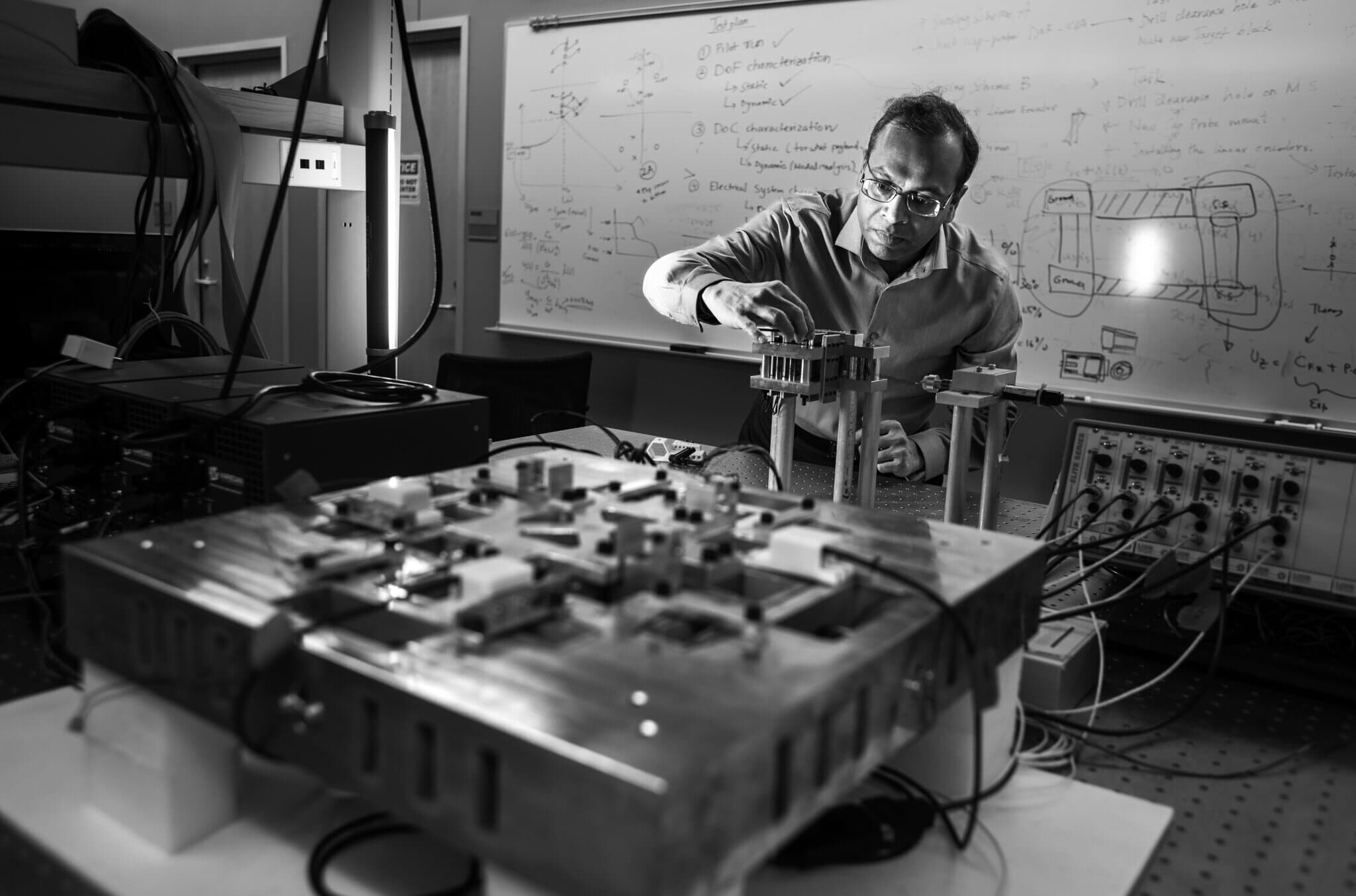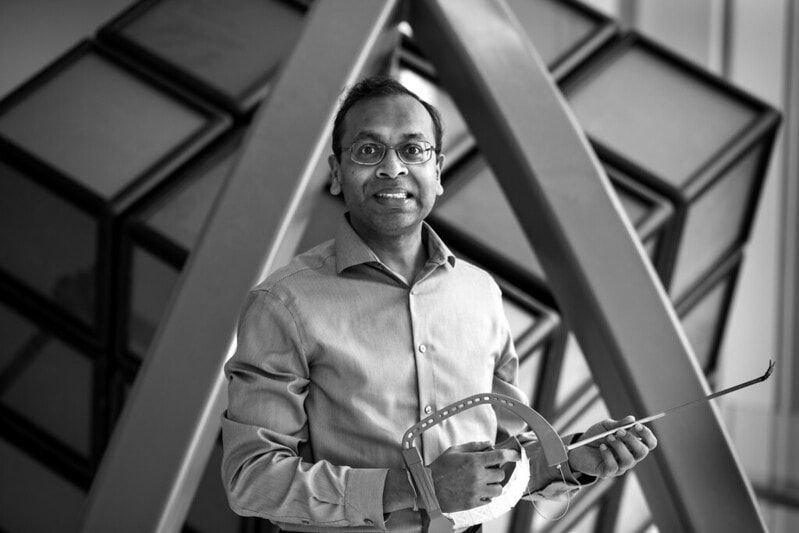
Democratizing minimally-invasive surgery
NAE profile: Shorya Awtar, mechanical engineering

NAE profile: Shorya Awtar, mechanical engineering
Get to know Michigan Engineering’s National Academy of Engineering members.
Roboticist and entrepreneur Shorya Awtar invented game-changing surgical devices to make minimally invasive surgery more affordable and accessible around the world. Then he co-founded a startup, called FlexDex, to bring the products to market where they could benefit both surgeons and patients. Compared with traditional open surgeries, minimally invasive procedures reduce patients’ trauma, blood loss, recovery time and pain. For these achievements, Awtar was elected to the National Academy of Engineering in 2023. View the NAE citation.
Beyond FlexDex, Awtar is a prolific innovator with more than three dozen inventions that are patented or patent-pending, including HIPERNAP technology for wafer inspection in semiconductor chips manufacturing, and the PREACT technology for reducing passenger motion sickness in road vehicles. He has also founded or co-founded multiple startups.
One of the surgical devices Awtar invented and developed – an affordable, ergonomic, hand-held “needle driver” for stitching inside the body – can stand in for a multi-million-dollar robotic system in many surgeries. This product has now been used in thousands of clinical procedures by surgeons in more than a dozen countries worldwide. Several of Awtar’s other technologies are currently being developed for industrial and commercial adoption.
More on Shorya Awtar

Awtar: “As far back as I can remember, I wanted to be an engineer. On one hand I really liked science and math, but at the same time I also loved arts and crafts and building things. Legos, wood working, clay modeling, machining – you name it. With no internet at the time, I spent most afternoons taking things apart around the house – and sometimes fixing them back together.
“Over time, I was very fortunate to get the education and opportunities where I could channel my interests towards learning engineering principles and methods, exploring exciting research avenues, and developing new ideas. At various times in my professional journey, I have been an academic, a researcher, an educator, and an entrepreneur. But at my core I have always remained an engineer, which to me means creating practical solutions to societal problems.
“The remarkable thing is that I still get to design and build machines and robots, just like when I was a kid. The difference is that now I also strive to make meaningful impacts and contributions.”
Awtar: “When I was working in the industry 17 years ago, I saw one of the first demos of a robotic surgery system. While I was amazed by the technology, I was also taken aback by its price tag.
“My mother in India had recently undergone an open hysterectomy. It was a brutal procedure with a lot of blood loss and pain and a long recovery. Around the same time, here in the US, my wife had to get an emergency appendectomy and once again, they did an invasive open procedure. So it became clear to me that there was a need for affordable instruments and accessible technologies that could enable minimally invasive surgery anywhere in the world.
“I knew there had to be a better solution, even though I didn’t know what it was at the time – but something that did not cost millions of dollars. Since pursuing your own crazy ideas is not really feasible in the corporate world, I decided to quit and instead seek a professional path where I had the intellectual freedom to explore all kinds of engineering challenges and societal problems that I felt strongly about.
“I was incredibly fortunate that U-M took a chance on me by offering me a faculty position. The beauty of our U-M ecosystem is that as long as one aspires to take on high-risk yet impactful challenges, the resources, the support system and the intellectual freedom available are amazing. These elements are so essential for discoveries and innovations to sprout up and thrive.”
Awtar: “It is okay to be uncomfortable. It is okay to feel out of place. It is okay to have a sense that perhaps you are a misfit – as long as you have clarity of purpose. Pursue that purpose in spite of doubts and challenges. It may sometimes seem like you don’t have the necessary skills or the resources. But for most people, what you have is probably sufficient to make a meaningful step in the direction of whatever it is that you feel passionate about.”
Awtar: “Going from being academic to an entrepreneur, I was initially a bit hesitant. Having come up with various promising ideas and technologies, I would look for other people to take the next step of bringing these technologies to the market. But it is very hard to find someone who has the same level of passion and conviction as the creator or inventor of an idea. Unfortunately, that is where many university based innovations wither and their potential benefits fail to reach the society.
“I didn’t want my ideas to be trapped in publications and patents. I wanted to make a more direct societal impact. Luckily, I had role models who had taken ideas all the way from conception to product launch. And gradually I was able to learn the ropes of technology transfer. It was difficult but very worthwhile.
“Beyond that, there’s very little that I can complain about, to be honest. While there are inherent challenges and a high failure rate associated with pursuing difficult goals, we are fortunate to have access to incredible resources and opportunities at U-M and beyond. Any success is built on hundreds of failures and stumbles, and my story is no different. You just persist in spite of the odds.
“To be recognized by the NAE for my efforts is truly special and humbling. The reality is that there are countless highly accomplished engineers making remarkable impact every day. I just got very lucky to be selected by my peers.”
Awtar: “In the context of robotics, I think one of the biggest challenges is addressing concerns about what this does to the jobs that people perform right now. My sense is that as long as these concerns are addressed with proper regulation, the utility of these technologies to society is significant. They can reduce physical and mental burden for people, and help alleviate tasks that are mundane or inherently dangerous. In all these areas, I believe robotics, automation and AI are going to be transformative, just like the internet or electricity have been transformative.
“And I believe that robotics and automation do not always have to be complex, bulky, and expensive. When done right, robotics can lead to efficient, cost-saving and sustainable solutions for society.”
Quotes edited from interview transcript between Shorya Awtar and Marcin Szczcepanski.